Top News
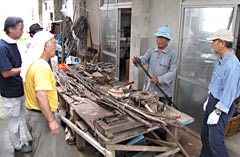
July 1, 2012 Takahiro Arashiro of Ryukyu Shimpo
Members of the Nakijin Castle guide volunteer group, Nakijin Gusuku wo Manabu Kai have made 60 canes so seniors and disabled people can enjoy the tour of the castle ruins.
They collected wood of the Randia canthioides (dashicha or dashika in the Okinawan dialect) from the mountain area of the Yambaru and dried them out for two months.
On June 11, members gathered at Shutoku Sakihama’s house in Taira, Nago, and finished making the canes under Sakihama’s guidance.
Randia canthioides blossoms with white flowers in the early summer. Its wood is dense, hard, and elastic. According to the mythology in the book, Ryukyu Shinto ki, written by Taichu Shonin, who introduced Jodo shu to the Ryukyu Islands, the Ryukyuan gods of creation, Amamikiyo and Shinerikiyo created the world by making mountains with dashicha.
At Sakihama’s house, through a process of trial and error, the members of the group worked to adjust the canes to the appropriate length and grip.
Vice chairman of the group, Isao Otahara, looks forward to telling people about the creation myth when members guide visitors around the castle ruins.
(English translation by T&CT, Megumi Chibana and Mark Ealey)
Go to Japanese
June 30, 2012 Ryukyu Shimpo
On June 30, for the first time since his inauguration Defense Minister Satoshi Morimoto visited Okinawa to explain the plan for the MV-22 Osprey vertical take-off and landing transport aircraft’s deployment to U.S. Marine Corps Futenma Air Station. That afternoon, he visited Ginowan Municipal Office to meet Mayor Atsushi Sakima.
The Marine Corps plans to operate the MV-22 squadrons from Futenma Air Station without restrictions. In this regard, the Mayor stated, “As the Ginowan mayor, I must ensure the security of the lives and property of more than 94000 citizens. I do not wish to accept the messages you have brought.” Sakima then asked the Defense Minister to put a stop to the Osprey deployment.
After his meeting with the mayor, with regard to the Osprey crashes in April and June, Morimoto told reporters, “They are very serious accidents. We want to come up with a solution after we find out what caused the accidents.”
(English translation by T&CT, Mark Ealey)
Go to Japanese

July 1, 2012 Ryukyu Shimpo
In the morning of July 1, at the Okinawa Prefectural Office, Defense Minister Satoshi Morimoto met Okinawa Governor Hirokazu Nakaima and explained the deployment plan to U.S. Marine Corps Air Station Futenma for the MV-22 Osprey vertical take-off and landing transport aircraft. After their meeting, when talking to the press corps, Nakaima condemned the governments of Japan and the United States, saying, “If the governments bulldoze their way ahead to deploy the Osprey aircraft, all U.S. bases will be closed immediately.”
At their meeting, Morimoto requested that the Okinawa Governor accept the Osprey deployment, stating, “It will lead to a marked improvement in the aviation support capabilities, humanitarian assistance and disaster-relief capacity for the U.S. Marine Corps.” Nakaima strongly opposed the Defense Minister’s stance, saying, “”I find it unbelievable that despite this aircraft having issues with its performance the U.S. military can bring anything it likes into Okinawa. There is nothing for it but to totally reject this.” The Governor responded by requesting that the Defense Minister stop the deployment plan.
After meeting with the Okinawa Governor, Morimoto met the mayors of the municipal offices related to the bases where the Osprey will operate, and in the morning of the same day, he left Okinawa to go to Iwakuni in a Self-Defense Force aircraft.
In late July, the U.S. Marine Corps will transport the Osprey aircraft to the U.S. Iwakuni base in Yamaguchi Prefecture, and in early October will start full-scale operations at Futenma Air Station. The United States will delay test flights of the Osprey until August, when it plans to provide the additional findings of the series of crashes that occurred in Morocco and Florida.
(English translation by T&CT, Mark Ealey)
Go to Japanese
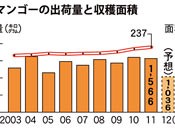
July 1, 2012 Ryukyu Shimpo
On June 29, the Prefectural Agriculture, Forestry and Fisheries Department Horticulture Center announced that the 2012 mango production forecast anticipates a figure of 1036 tons, a 33.8% decline from the previous year and the lowest level of shipment in the ten years since 2003.
The Horticulture Center explains that the 40 to 60% reduction in mangoes is because of last year’s typhoons, the high temperatures in October and November, and the reduced levels of sunlight from November to February. The low temperatures during the period of bloom in March and April and the slow pollination of flowers by insects also caused crop failure in some areas.
The forecast production levels by district are 310 tons, a 20.7% decline, in the northern region, 57 tons, a 38.7% decline, in the central region, 289 tons, a 37.0% decline, in the southern region, 274 tons, a 47.3% decline in the Miyako region, and 106 tons, a 2.9% increase in the Yaeyama region.
As a countermeasure, farmers were instructed to increase the fruit-setting from one fruit per branch to two or three fruits per branch. Also, a greenhouse facility check-up for typhoons and drainage maintenance will be conducted.
(English translation by T&CT, Megumi Chibana and Mark Ealey)
Go to Japanese

June 30, 2012 Ryukyu Shimpo
On July 1, TransAsia Airways, a Taiwan-based medium-sized international carrier, launched regular charter flights between Naha and Taipei. The flight runs once a day, and this is the first time that the company has operated such flights from Taipei to Naha.
On June 20, at the Okinawa Prefectural Office, a sales representative of the company (second from the left in the photograph) held a press conference, saying, “Taiwanese tourists represent the largest number of foreign tourists coming to Okinawa. I am responsible for promoting exchange between Taiwan and Okinawa, and marketing the appeal of both regions.” The company aims to have flights running to at least 80% capacity in the first fiscal year.
Aiming to commence regular flights from September, the company intends to apply in July to the Ministry of Land, Infrastructure, Transport and Tourism for an operating license. Considering that New Ishigaki Airport will be opened in March 2013 and the construction of the Naha Airport international terminal will be completed in January 2014, the company hopes to start flights between Ishigaki and Taipei, and between Naha and Kaohsiung.
One flight is scheduled to take off from Naha at 10:30am and arrive at Taipei at 11:00am, and another is scheduled to take off from Taipei at 7:15am and arrive at Naha at 9:30am. The total number of seats on the plane is 182.
(English translation by T&CT, Mark Ealey)
Go to Japanese
June 30, 2012 Ryukyu Shimpo
The Okinawa Awamori Distillers Association decided to impose strict quality standards following a case in which nine distilleries in Okinawa violated the Japan Sake Shochu Makers Association’s code of fair competition regarding the quality indication of kusu, or aged awamori. Although the association had previously specified that distilleries are able to name awamori as kusu if the percentage of the awamori aged for three years accounts for more than 51% of the liquor, it increased that ratio to 100% on June 29. The association is scheduled to announce the change of quality setting at the beginning of July.
Nine distilleries violated the regulations specifying that distilleries cannot name awamori as kusu if the percentage of awamori aged for three years is less than 50% of the liquor after being replenished. The case was brought to light when the Japan Sake Shochu Makers Association issued a warning and instruction to the distilleries. Following the case, the Okinawa Awamori Distillers Association had discussed imposing stricter quality standards to prevent such a case from reoccurring.
That same day, the association held a board meeting in which it voted to implement the more stringent standard. In cooperation with the Okinawa General Bureau, the association is currently preparing the legal procedures required to implement the new standard.
According to people concerned, the association aims to revise the rule within this fiscal year, but it is expected that member companies may protest about the revision because their production costs will increase and inventory levels will grow.
In 2004, as a voluntary regulation for the indication of quality, the association imposed strict standards on the indication of awamori storage years for kusu. Awamori can only be named as kusu if awamori aged for the number of years indicated accounts for the total volume, or if the awamori is blended with something aged for more than the number of years indicated. The revised regulations will include those voluntary standards. Application has been made to the central government, so the revised regulations will be implemented from the day they are approved.
Takeshi Sakumoto, president of the association, asked for understanding from consumers and companies, saying, “Although companies that follow the rules and develop new products will be inconvenienced by having to deal with inventory, issues of safety and understandability are important for consumers. All the people involved in the industry should strive to improve the quality of their products.”
(English translation by T&CT, Mark Ealey)
Go to Japanese
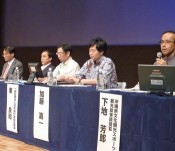
June 23, 2012 Ryukyu Shimpo
On June 22, at the Okinawa Convention Center in Ginowan, as part of the Japan-China Tourism Exchange Conference, the Okinawa Prefectural Government (OPG) and the Okinawa Convention and Visitors Bureau held a symposium on tourism. The conference was held to mark the 40th anniversary of the normalization of diplomatic relations between Japan and China, the 15th anniversary of the establishment of Okinawa-Fujian friendship relations, and the 40th anniversary of the reversion of Okinawa to Japanese sovereignty. In a subcommittee meeting it was reported that the total number of multiple-entry visas for Chinese tourists is expected to reach 20000 in the first twelve months since these visas were first issued last July. All of the panelists and participants confirmed their desire to develop a better understanding of the new level of tourism between Japan and
China that has been stimulated by the multiple-entry visas.
The symposium was attended by the vice commissioner for international affairs, Tadashi Shimura, the vice chairman of the China National Tourism Administration, Wu Yue Zhong, the director of the Japan Association of Travel Agents, Yoshikazu Higashi, columnist Yoshikazu Kato, and the deputy director general in charge of tourism of the OPG, Yoshiro Shimoji, as panelists discussing the meaning and the future of tourist exchanges.
All of the panelists shared the view that tourism is important to boost understanding between Japan and China. Wu stated, “In order to deepen mutual understanding and trust, we would like to encourage tourism exchanges in concert with the Japanese tourism industry.”
Kato pointed out that because a stable political environment is a prerequisite for Japan-China exchange, cooperation from the national governments and strategies that involve the tourism industry are very important. He also commented, “From an historical and a geographical point of view, Okinawa has the potential to serve as a bridge to connect the two nations.”
With regard to strategies for promoting tourism, Shimura said that is important to enhance tourists’ satisfaction, saying, “I hope that Okinawa continues to create and advertise the new facets of its tourism profile, such as sports and medical-related initiatives.”
Higashi stated that attracting Chinese tourists represents a huge business opportunity for local communities, and suggested that private companies should ask the government to improve the environment to help enhance visitors’ satisfaction.
In the context of increasing numbers of inbound Chinese tourists, Wu requested that the conditions for the issuing of multiple-entry visas be eased. Shimoji also suggested relaxing the visa regulations in stages in order to further enhance mutual exchange. He said, “Okinawa is a model for multiple-entry visas. If we can further develop mutual understanding that will lead to the easing of the visa’s requirements. I hope that Okinawa can become a place where people think about exchange with others and about coexistence.”
(English translation by T&CT, Lima Tokumori and Mark Ealey)
Go to Japanese
June 25, 2012 Hideki Matsudo of Ryukyu Shimpo reports from Washington D.C.
MV-22 Osprey vertical take-off and landing transport aircraft are to be deployed to U.S. Marine Corps Futenma Air Station in August. The early retirement of the leader of the accident investigation board for the Osprey crash in Afghanistan in 2010 was followed by the Air Force’s decision to remove the commander of the Osprey squadron. According to a report in Wired magazine on June 21, high-ranking U.S. Air Force officials have applied pressure to amend the report of the accident investigation board from mechanical failure to “human error” as the cause of the crash. The president of the board stated that the cause of the crash in Afghanistan in 2010 was mechanical failure. The writer of the magazine cast doubt on the Air Force’s announcement that the crash in Florida on June 13 was not the result of mechanical failure.
Despite the investigation not being completed, the Department of Defense has repeatedly stressed that there is no problem with the aircraft. Knowing that the Okinawan people’s opposition to the deployment of the Osprey is growing, the United States seems to be rushing to settle the situation.
After the crash in Florida, Lieutenant Colonel Matt Glover of the 8th Special Operations Squadron, who was in charge when the Osprey went down during a training exercise, was sacked. According to the report issued by the electronic version of Inside Defense, a U.S. Defense specialty journal, Colonel James Slife, the 1st Special Operations Wing chief, said, “The commander of the 8th Special Operations Squadron was relieved because of a loss of confidence in his ability to effectively command the unit.” Some specialists suggest that the U.S. Air Force is trying to dampen down the controversy surrounding the Osprey by stating that human error caused the crash.
When the Air Force had not completed the investigation to find the evidence of causing the crash, Colonel Slife suggested that there was no reason to suspect a design flaw, and the squadron commander was relieved of his position. The writer for Wired suggests that the Air Force has a history of blaming people when its warplanes malfunction. In the article, the writer touched upon the controversy over the investigation report of the Osprey crash in Afghanistan in 2010. When a CV-22 crashed, the lead investigator Brigadier General Donald Harvel initially attributed the incident in part to engine failure. However, Harvel said the Air Force leaders leaned on him to place the blame on the pilots, instead.
Harvel retired from the military after he submitted the report. In an article of the
Air Force Times, weekly magazine of the U.S. Air Force, published in January, 2011, He commented, “There was absolutely a lot of pressure to change my report.” He also said, “My heart and brain said it was not pilot error. I stuck with what I thought was the truth.”
According to Wired, in 2001 the Marine Corps commandant fired Lieutenant Colonel Odin Lieberman, head of the Corps’ Osprey training squadron, after he was accused of falsifying maintenance records in order to mask the aircraft’s tiltrotor design flaws.
(English translation by T&CT, Mark Ealey)
Go to Japanese
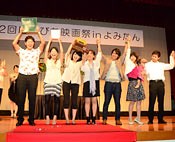
June 24, 2012 Ryukyu Shimpo
On June 10, at the Zampa Royal Hotel in Yomitan, the final of the 2nd Nibichi Festival was held. This festival is a video contest for works shown as entertainment at wedding parties. The Grand Prize went to Pythagora-iwaitch, a video produced by members of a volleyball club.
The prize-winning work was made in the style of PythagoraSwitch, a Japanese educational television program that has been running since 2002. It shows people trying throw volleyballs at many targets on which the word “Celebration” was written, and involves an elaborate approach to filming in venues such as in a park, where the members of the club become pins in a pinball game on a large slide. Ginowan resident Munetaka Kanna, who created the winning work said, “I wanted to make something good that no-one had ever seen before. I wanted to win first prize.”
Pythagora-iwaitch was shown at the wedding reception of Nakagusuku resident Yuko Senaga, who said, “We are very happy to have the piece that was shown at our wedding reception party win the Grand Prize for this category of entertainment in Okinawa.”
Hiroki Kawada of the Okinawan comedy duo Garage Sale made an appearance at the finals stage of the contest and applauded the finalists, saying, “Your works are really good and made me relax. I hope that you go on create more of this kind of work.”
At the venue, the top five works selected by popular vote from among the 25 applicants were screened. About 150 people enjoyed the mature and original videos.
(English translation by T&CT, Mark Ealey)
Go to Japanese
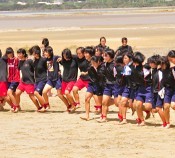
June 23, 2012 Ryukyu Shimpo
On June 17, at Shimojiyonaha, on Miyako-jima, the 22nd Sanitsu Beach Carnival was held at Sanitsu Beach, a large mudflat that appears when the tide is low.
Many locals enjoyed taking advantage of the tideland to play games such as a relay race in the shallow water, a tug-of-war, a treasure hunt and an eleven-legged race. In the Miyako Sumo Wrestling Tournament, teams from other areas such as Kume-jima also took part making the bouts all the more interesting.
Shiho Nakama, a member of the girls’ volleyball A team of Hisamatsu Junior High School which won the eleven-legged race, said “We only practiced twice but we were able to win thanks to good teamwork. I did not expect us to do so well, so I’m very pleased.”
Yonaha Bay, where Sanitsu Beach is located, will be included as a registered wetland under the Ramsar Convention at the Conference of the Contracting Parties to the Convention on Wetlands, which will be held in Romania in July. The carnival will continue to be held even after that registration is complete.
(English translation by T&CT, Lima Tokumori and Mark Ealey)
Go to Japanese
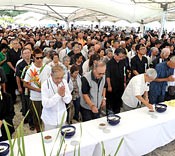
June 24, 2012 Ryukyu Shimpo
On June 23, at the Peace Memorial Park in Mabuni, Itoman, the Okinawa Prefectural Government and the Prefectural Assembly held a ceremony to commemorate the victims of the Battle of Okinawa. The participants prayed for the more than 200000 people killed in the battle, and issued a pledge for world peace. Commemorative ceremonies were held at war memorials at various locations throughout Okinawa and people prayed for the repose of the victim’s souls. Okinawa marked the 67th anniversary of the end of the Battle of Okinawa amid growing protest against the alternative facility construction plan for the relocation of the U.S. Marine Corps Air Station Futenma to Henoko in Nago, and the deployment of the controversial MV-22 Osprey vertical take-off and landing transport aircraft. Naeko Teruya, chairman of Bereaved Families of Okinawa Prefecture War Dead Joint Association, and Zenshin Takamine, chairman of the Okinawa Prefectural Assembly, called for the cancellation of the Osprey deployment plan, stating that they cannot accept the Osprey coming to Futenma Air Station.
Bereaved family members visited Mabuni one after another early in the morning. Some of them traced their fingers over the names of the war dead inscribed in the Cornerstone of Peace at Mabuni, and prayed. Some elderly people told their grandchildren and great-grandchildren about the people they knew who died during the war.
About 5500 people participated in the ceremony. Okinawa Governor Hirokazu Nakaima praised the progress Okinawa has made, recently marking the 40th anniversary of its reversion to Japanese sovereignty, saying, “Okinawa has developed impressively.” Nakaima referred to the excessive burden placed on Okinawa by hosting the U.S. military bases, saying, “I demand that the Japanese and U.S. governments relocate Futenma Air Station outside of the prefecture, and carry out fundamental revisions to the Japan-U.S. Status-of-Forces Agreement.”
Prime Minister Yoshihiko Noda said, “I am overwhelmed with shame regarding the fact that we have imposed a massive burden on Okinawan people in hosting the U.S. military bases for such a long time. I promise to do my utmost to ease the burden with tangible progress.” Takahiro Yokomichi, speaker of the Japanese House of Representatives, expressed understanding of the remarks made by Okinawa governor, saying, “We should not ignore the Okinawan people’s significant concerns about the Henoko relocation plan and the deployment of the Osprey to Futenma Air Station. There also needs to be a fundamental revision of the Japan-U.S. Status-of-Forces Agreement.”
Teruya said, “The plan to relocate the facilities at Futenma to Henoko, and the Osprey deployment plan could result in an even greater burden on the Okinawan people. This is not acceptable.” When Mina Kinjo of Shuri High School read a peace poem entitled Think of the names inscribed in the Cornerstone of Peace, the participants fell silent, some wiping tears from their eyes.
(English translation by T&CT, Mark Ealey)
Go to Japanese








 Webcam(Kokusai Street)
Webcam(Kokusai Street)


